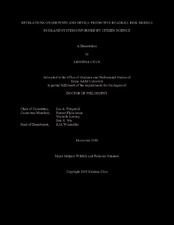| dc.description.abstract | Habitat change is widely considered the primary cause of biodiversity loss and the expansion of infrastructure, especially roads, will bring ecological consequences to biodiversity. Consequences of roads on biodiversity include habitat loss, fragmentation, and among the most insidious causes of impoverishment of vertebrate populations, roadkill. My dissertation focused on understanding the magnitude of roadkill and developed novel predictive roadkill risk modeling as a conservation tool in two island systems. We conducted the first synthesis of data from a large citizen science program, the Taiwan Roadkill Observation Network (TaiRON), and quantified the magnitude of roadkill in Taiwan to understand which taxa were of greatest conservation need. Notably, the study revealed that snakes were the largest proportion of all roadkill (35%) and 26% of snake roadkills were of protected species. Additionally, the top 23 species of a total 496 species ranked by roadkill abundance made up 50% of the observations. Importantly, certain taxonomic groups were disproportionately killed on roads, and a small number of species account for most of the mortality. We analyzed TaiRON roadkill observations in a novel use of the SDM, MaxEnt, to predict relative roadkill risk across the Taiwan road network and to identify high roadkill risk areas for the taxa with conservation need. Our analyses highlighted key environmental variables that impacted roadkill risk for different guilds and species modeled. The roadkill prediction models performed well across ecological levels on a national scale.
This study demonstrated that the predictive roadkill models are ecologically and geographically scalable to address ecological questions of interest. Finally, we developed a predictive relative roadkill risk model for the Tasmanian devil (Sarcophilus harrisii). I compared the applicability of the roadkill risk modeling methodology in a contrasting landscape to expose challenges in other systems. Relative to Taiwan, Tasmania is sparsely populated by humans, has a low road density, and has a less established roadkill monitoring program. Nevertheless, high model performance in predicting roadkill risk in a contrasting system suggests global applicability of the methodology, even when roadkill data is less abundant than from databases of larger programs. | en |


